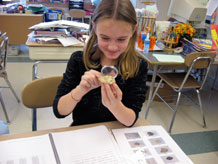What can we learn about minerals by observing them carefully?
2. Explore the minerals

Distribute a tray of minerals to each group. The students are already experienced observers of earth materials. Have them pass the samples around, identify each mineral from the photo key, and briefly inspect each mineral by touch, by eye, and with the magnifier. Then ask each student to select two minerals for closer investigation and to record their observations in their notebooks.
Here's where the procedure differs from last time. While students are encouraged to record any information about the minerals that interests them, they are specifically asked to collect information about the following five properties of minerals. They are given a table to help them organize these observations [Observations of some minerals]. Together, review the five properties and explain how to record observations in the table.
| Property | What to record |
|---|---|
| Color | Describe the color of the mineral. If it's helpful, compare it with the color of something else. |
| Luster | Luster refers to the way a mineral reflects light. Is the mineral shiny or dull? |
| Hardness | Can you scratch the mineral with your fingernail? Use the magnifier to take a close look. If your fingernail leaves a mark, the mineral is fairly soft, answer No; if your fingernail doesn't leave a mark, it is pretty hard, answer Yes. |
| Translucence | Does light shine through the mineral? Answer Yes or No. |
| Friability | Friable means that the material crumbles easily. Can you break off small pieces of the mineral just by rubbing it with your fingers? Answer Yes or No. If Yes, the mineral is friable. |
Graphite is messy — as anyone who has ever emptied a pencil sharpener can tell you! Soft, flaky, and rather greasy, it smudges easily and leaves dark-colored marks. Students should handle the graphite sample loosely, taking care not to drop it. Marks can be removed from paper with an eraser; from hands with soap and water.
Letter from the Engineer
It comes from the Earth
Everything that people make — toothpaste, sneakers, blue jeans, eye glasses, our houses and everything in them — comes originally from natural Earth materials, not just the rocks and minerals we are exploring in class, but many, many more rocks and minerals that are found on Earth. Often different natural Earth materials are mixed together to make a new material, but everything starts off as a natural Earth material. When scientists and engineers take natural Earth materials and turn them into things that are useful to people, we call the result technology. So a pencil is considered technology, just as an automobile is, or a cell phone is.
The more scientists and engineers learn about the properties of natural Earth materials, as you have been doing, the more ideas they get for how to use those materials in different ways. For example, once people noticed that graphite is soft and slippery, and that tiny pieces separate very easily from it (friable), they realized it could be used to make marks or drawings, and eventually someone invented the pencil.
Scientists and engineers will sometimes study the same materials, but they usually have different purposes. For example, the scientist might study graphite to better understand what makes it slippery (scientists study the natural world) while the engineer might study graphite to discover how long it can hold a point before it needs to be sharpened again (engineers solve problems).



